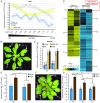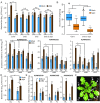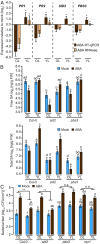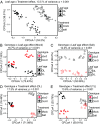Balancing trade-offs between biotic and abiotic stress responses through leaf age-dependent variation in stress hormone cross-talk
- PMID: 30674663
- PMCID: PMC6369802
- DOI: 10.1073/pnas.1817233116
Balancing trade-offs between biotic and abiotic stress responses through leaf age-dependent variation in stress hormone cross-talk
Abstract
In nature, plants must respond to multiple stresses simultaneously, which likely demands cross-talk between stress-response pathways to minimize fitness costs. Here we provide genetic evidence that biotic and abiotic stress responses are differentially prioritized in Arabidopsis thaliana leaves of different ages to maintain growth and reproduction under combined biotic and abiotic stresses. Abiotic stresses, such as high salinity and drought, blunted immune responses in older rosette leaves through the phytohormone abscisic acid signaling, whereas this antagonistic effect was blocked in younger rosette leaves by PBS3, a signaling component of the defense phytohormone salicylic acid. Plants lacking PBS3 exhibited enhanced abiotic stress tolerance at the cost of decreased fitness under combined biotic and abiotic stresses. Together with this role, PBS3 is also indispensable for the establishment of salt stress- and leaf age-dependent phyllosphere bacterial communities. Collectively, our work reveals a mechanism that balances trade-offs upon conflicting stresses at the organism level and identifies a genetic intersection among plant immunity, leaf microbiota, and abiotic stress tolerance.
Keywords: combined stress; microbiota; phytohormone; plant fitness; stress trade-off.
Copyright © 2019 the Author(s). Published by PNAS.
Conflict of interest statement
The authors declare no conflict of interest.
Figures







Similar articles
-
Plant hormone-mediated regulation of stress responses.BMC Plant Biol. 2016 Apr 14;16:86. doi: 10.1186/s12870-016-0771-y. BMC Plant Biol. 2016. PMID: 27079791 Free PMC article. Review.
-
Vascular plant one-zinc-finger protein 1/2 transcription factors regulate abiotic and biotic stress responses in Arabidopsis.Plant J. 2013 Mar;73(5):761-75. doi: 10.1111/tpj.12069. Epub 2013 Feb 12. Plant J. 2013. PMID: 23167462
-
PBS3: a versatile player in and beyond salicylic acid biosynthesis in Arabidopsis.New Phytol. 2023 Jan;237(2):414-422. doi: 10.1111/nph.18558. Epub 2022 Nov 24. New Phytol. 2023. PMID: 36263689
-
Plant Immune System: Crosstalk Between Responses to Biotic and Abiotic Stresses the Missing Link in Understanding Plant Defence.Curr Issues Mol Biol. 2017;23:1-16. doi: 10.21775/cimb.023.001. Epub 2017 Feb 3. Curr Issues Mol Biol. 2017. PMID: 28154243 Review.
-
Plant Hormone Signaling Crosstalks between Biotic and Abiotic Stress Responses.Int J Mol Sci. 2018 Oct 17;19(10):3206. doi: 10.3390/ijms19103206. Int J Mol Sci. 2018. PMID: 30336563 Free PMC article. Review.
Cited by
-
Advancement in the molecular perspective of plant-endophytic interaction to mitigate drought stress in plants.Front Microbiol. 2022 Sep 2;13:981355. doi: 10.3389/fmicb.2022.981355. eCollection 2022. Front Microbiol. 2022. PMID: 36118190 Free PMC article. Review.
-
Elevated CO2 enhanced water use efficiency of wheat to progressive drought stress but not on maize.Front Plant Sci. 2022 Nov 17;13:953712. doi: 10.3389/fpls.2022.953712. eCollection 2022. Front Plant Sci. 2022. PMID: 36466229 Free PMC article.
-
Linking Reactive Oxygen Species (ROS) to Abiotic and Biotic Feedbacks in Plant Microbiomes: The Dose Makes the Poison.Int J Mol Sci. 2022 Apr 15;23(8):4402. doi: 10.3390/ijms23084402. Int J Mol Sci. 2022. PMID: 35457220 Free PMC article. Review.
-
Tailoring plant-associated microbial inoculants in agriculture: a roadmap for successful application.J Exp Bot. 2020 Jun 26;71(13):3878-3901. doi: 10.1093/jxb/eraa111. J Exp Bot. 2020. PMID: 32157287 Free PMC article. Review.
-
The plant cuticle regulates apoplastic transport of salicylic acid during systemic acquired resistance.Sci Adv. 2020 May 6;6(19):eaaz0478. doi: 10.1126/sciadv.aaz0478. eCollection 2020 May. Sci Adv. 2020. PMID: 32494705 Free PMC article.
References
-
- Pieterse CM, Leon-Reyes A, Van der Ent S, Van Wees SC. Networking by small-molecule hormones in plant immunity. Nat Chem Biol. 2009;5:308–316. - PubMed
-
- Bostock RM, Pye MF, Roubtsova TV. Predisposition in plant disease: Exploiting the nexus in abiotic and biotic stress perception and response. Annu Rev Phytopathol. 2014;52:517–549. - PubMed
-
- Wu Y, et al. Dual function of Arabidopsis ATAF1 in abiotic and biotic stress responses. Cell Res. 2009;19:1279–1290. - PubMed
-
- Berens ML, Berry HM, Mine A, Argueso CT, Tsuda K. Evolution of hormone signaling networks in plant defense. Annu Rev Phytopathol. 2017;55:401–425. - PubMed
Publication types
MeSH terms
Substances
LinkOut - more resources
Full Text Sources
Other Literature Sources
Molecular Biology Databases

